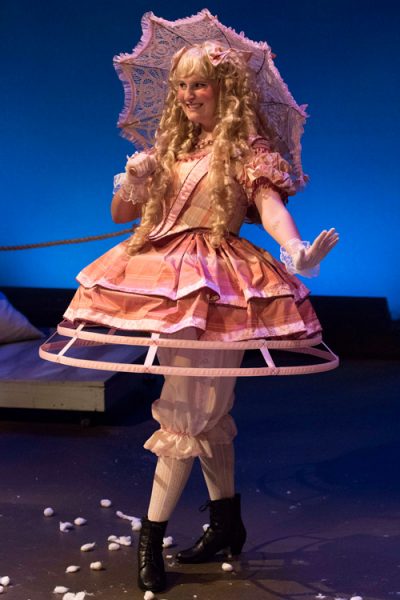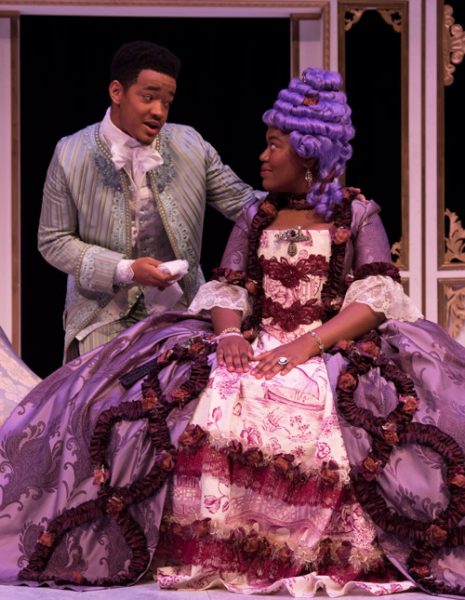Stitch Fix

A peek inside a shop that teaches.
Only a few people know about the magical treasure that fills an ordinary room in the Central Warehouse Building on the Statesboro Campus. The treasure trove is Georgia Southern University’s very own costume shop. It features a collection of costumes from years of student productions. For most actors, costumes help them transform into the characters they play on stage.
“You can work on a character for months but you never fully have the movement or personality down until you have the clothes on,” said Tyra Wilson, a senior theatre major who has been cast in five main stage productions at Georgia Southern. “As an actor, it fully throws you into the world to wear the characters clothes, shoes and in some cases jewelry. Getting to see the character shine through on your own body helps the actor disappear and commit.”
“We have all kinds of garments and accessories,” said Professor Sarah McCarroll, Ph.D., who teaches theatre history, script analysis and costume design. “They range from the support garments required for specific kinds of plays or productions—women’s corsets for when we do period plays—to men’s and women’s clothing representing a full range of historical periods from Classical Greek through the 18th century right up to today.”
McCarroll and her staff of student workers manage the shop, which supports the University’s Theatre and Performance program. At least four shows are performed each academic year. Last spring’s production of “Chicago, The Musical,” had upward of 60 costumes. Many were store bought, but the professor and her staff built a number of daywear pieces, since the production is set in the 1920s. For the recent production of “The Octoroon,” faculty and students created costumes for the 19th century period piece.
“You can’t run to the mall for a dress from 1895,” McCarroll said. “We also build clothing if there is a specific need for a show—if a costume has to be able to work in a certain way, or the text requires a very specific look—or if a designer wants a specific look for a piece of contemporary clothing, and it cannot be found for purchase. In general, we don’t make much contemporary clothing. It’s actually much cheaper for me to buy garments from today, especially if I have good luck at Goodwill.”

Learning by Doing
No formal classes are taught in the shop, but it does serve as an informal training program for students in the Theatre and Performance program.
“We want students who want to be designers and technicians learning by doing in the same way that our actors are learning by doing in the production program,” explained McCarroll. “All student employees are hired as stitchers, which means they spend a lot of time in front of sewing machines. As their skill sets increase, they may do some cutting of garments. We all do crafts work when it comes time to make or decorate accessories, and most shop staff work on some or all of the wardrobe crews for shows, so they get experience with hair and makeup.”
The costume shop is filled with sewing machines, sergers, irons, steamers, dress forms, all kinds of sewing supplies and notions (like scissors, pins, thread, snaps, zippers, elastic, bias tape, belt buckles, beeswax, and—most importantly—seam rippers to undo mistakes), washers and dryers, an industrial steam kettle used for dying fabric, craft supplies, fabric and trim of all kinds. The hanging stock includes pants, shirts, vests, breeches, capes, suits, blouses, hoop skirts, waistcoats, day and formal dresses, men’s and women’s period garments from the classical period to the 1890s, and fantasy wear. There are all kinds of accessories—purses, aprons, shoes, jewelry, armor and wigs.
In addition to helping student actors learn how to work with designers and technicians when they have costume fittings, the shop allows staff to maintain control of the artistic product. They work closely with the director and other designers for a “unified product in the end or something that looks like it all fits intentionally and goes together really well.”
“Fittings are always a fun experience for me,” said Wilson, who has worked as a stitcher and an assistant and is planning for a career in artistic management. “Seeing what my designer, in most cases Professor Sarah McCarroll, has in mind for my clothes tends to give me ideas about traits my character may or may not have. I always come in with questions regarding my blocking or movement on stage, to see if the costume can do what I want my body to be able to do to tell my piece of the story.”
After each show, costumes and accessories are stored in the shop. Some may be reused in future productions. McCarroll estimates there could be as many as 15,000 pieces in the facility.
— Sandra Bennett
